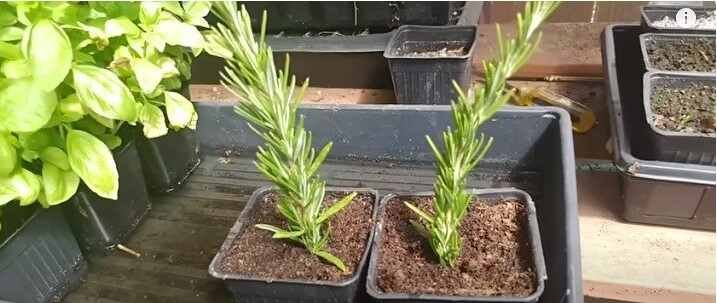Free, the absolute best price. Nobody ever complained about getting something for free. So let me show you how to make more rosemary plants from an existing plant for free.
Rosemary, probably the most popular perennial herb amongst growers. You know, you’ll find people growing rosemary not even for food, just as an ornamental. You know, much like lavender, it’s got these very cool purple flowers that come out fairly early in the spring. It’s perennial, so it doesn’t die back, it’s always green, and it’s very, very easy to grow and very forgiving. But for me, rosemary has an unbelievable flavor and scent to it. You know, of all the herbs, besides maybe basil, rosemary is the one that I always have to be growing. It’s also a big seller on the farm stand.
They’re growing rosemary from seed, even though it is a vigorous grower, can take years. It is so painful to watch that I’ve simply never attempted it. Fortunately, rosemary is dead easy to grow from cuttings.
Now, there’s two ways to do rosemary from cuttings, and for both methods, you only need three things. One, you need a cool glass to put them in. Number two, you need a pair of scissors. And number three, you need an exacto knife. So let’s get started.
So, for both methods, the rosemary cutting is harvested the exact same way. You want to take new shoots that haven’t flowered because they are the most likely to take rooting. This would be a good candidate here. The one beside it is another good candidate. Even some of these ones up top, they’ll work, they’ll root. You know, rosemary is very easy that way. So let’s go ahead and take a few cuttings. You want to cut them, you know, I usually do them about 10 inches long, that’s what I’ve had the most success with.
So step number two, you can use the exacto knife. So what you do is to take your rosemary and so the last, I’d say probably three to four inches, just get those leaves right off there. All right, so it leaves you with a bare stem. Take your exacto knife. What you want to do is you want to shave some of that outer layer off, okay? You see florists do this with cut flowers. The reason for this is you want to create more surface area for the water to get through and for the roots to start coming out.
So we’ll do one with the scissors to make your rosemary, the last of the leaves off, okay? Grab the scissors, okay? I assume with a sharp pair of scissors, this would be a lot easier, but it still works, just not as ideal. There we go. That’s two done. So just going to quickly do the other two using the exacto knife. One, there’s two.
Rooting Hormone:
All right, now got them all done, all four. So that is common to both methods of rooting your rosemary cuttings. So now is when the two methods diverge. So before I get to the two methods, here, I do want to mention something. A lot of people who will use this stuff, not particularly this brand, but IBA. So it’s, it’s in the Busic acid, what it is, it’s a rooting hormone. It really works, you know, it’s really good. Something like a rosemary, though, which seems to have adventitious stems, you don’t really need it. It won’t hurt your plants. It’ll probably make some of the fringe ones that wouldn’t root, root. I don’t like to use it because I want to grow the strongest rosemary, and I feel like it gives a lot of the ones that shouldn’t be rooting a crutch and gets them to go. So I don’t use it, but if you do, all you do is you wet the stem, dip it into the powder, and do one of the two methods that we’re about to discuss. Pretty easy stuff, but you don’t need to use it.
Method Number One

So this is where the two methods differentiate from each other. So method number one is the simplest. You take your pond water and your cool glass. You fill it up to about two inches above where your leaves end, and you simply drop them in, just like that. All right, now I do change the water about once a week. This does take about four weeks, and these guys will send out little white roots. And they do. When the roots get a, you know, pretty big, like maybe two inches long and there’s several of them, you know, maybe 10-15 roots, that is when you would pot them up, just into a regular potting mixture for small transplants or plugs. Lighter the better.
Method Number Two

So, as you can guess, method number two is simply potting these cuttings straight into soil. Now the great thing about the rosemary cuttings is the stems are quite woody. So you don’t want to make holes in your soil like you would for a lot of cuttings. Two reasons why: one, you don’t have to, and two, it could create an air pocket where the roots simply won’t be able to take hold. You know, you want that little white root when it first comes out of the stem to either hit water or hit wet soil. And so this way, if you just plonk it in like that, this guy, plug this one in like that. Now you generally want the whole stem to be buried. So what I’m going to do is I want to cut the tips off of these guys so that they sink all the way down. You could just use a taller pot, but this is what I have available. Just cut a bit off of here.
Those are woody stems. Okay, pop that guy in. Perfect. Like this guy, a little bit off, just a little bit because it was almost on the soil already. Put that guy in like that. There you go. Hey, a couple of rosemary cuttings.
So what you want to do, it’s about the same timeframe, maybe a little bit less because depending on your soil, you know, I’ve got a mixture of compost in here. I’ve got some alfalfa and canola meal, which does have rooting hormones in it. These guys can often go quicker than the stuff that’s in just the water. So what you want to do is you want to lightly tug on these guys, you know, in a few weeks to make sure that they’ve rooted. Now, rosemary will grow quickly, so it won’t take long, probably about a month to six weeks, that these four inch pots will be moved on the gallon pots, and that’s when the rosemary’s are ready for sale. If you’re not selling it, if you’re just transplanting it to somewhere in the garden or to a larger pot, you can simply go straight from these into your garden or into your 4 or 5 gallon pot, which is a great end location to grow your rosemary.
So that’s it, guys. Two different ways to root your rosemary cuttings. Easy, easy stuff. You know, rosemary is a staple in most vegetable growers’ gardens, and there’s a reason for that. It is so fragrant, it is so tasty, it is so versatile. You know, for red meat, white meat, fish, you know, for veggies. I do find it a little bit overpowering. So what I do is I would dry the rosemary first, you know, simply hang it in a cool dark place, much like you would your garlic. Only takes about 3 to 4 weeks to dry, and then put it in a simple spice shaker. It just takes the edge off of the fresh stuff. And if you ever make it roasted vegetables, even stir-fry vegetables, a little bit of that rosemary dust just kicks it into high gear.
Now, one thing to note with rosemary, it is a very, very vigorous plant. Do not think that you can just place it in a little corner in your garden and a little 2 by 2 plot and it’ll stay there. It is, it is like a tweener between a tree and a bush. It will grow large, it will take over, you know, a 10 by 10 foot area if you let it, just like lavender would. So I find if you’re not willing to do the pruning every year, just put it into a 5 or 6 gallon pot. It’ll be happy there, it probably won’t need to be repotted or replanted, you know, for five to eight years. You know, and by that time, you’re taking off your own cuttings and starting your own new little plants that you can simply just replace the big old bush. But yeah, just be very careful of where you put it in your garden.
So that’s it for today, guys. I hope you like rosemary as much as I do.



